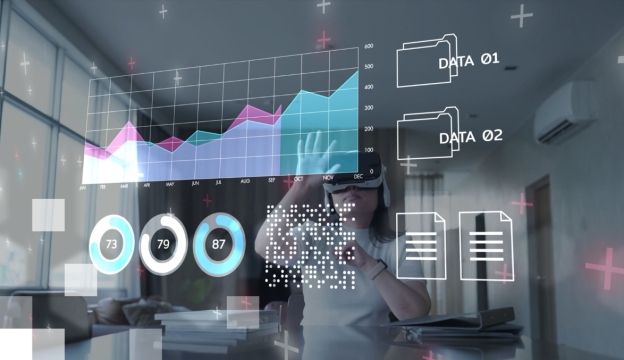Datu analīze ar Microsoft Power BI
Mācību ietvaros būs iespēja apgūt populārākās metodes datu modelēšanai, vizualizēšanai un analīzei, izmantojot Microsoft Power BI – kā piekļūt datiem, tos pareizi apstrādāt, izmantojot gan relāciju, gan ne-relāciju avotus, veidot interaktīvās un automatizējamās atskaites, kā arī veikt to kopīgošanu un pārvaldību.
Mācību kursa, tā programmas satura un materiālu izstrādātājs ir BDA.
Uzņēmumiem pieejams ES līdzfinansējums 50% līdz 70% apmērā.
Kopējās mācību izmaksas var mainīties atkarībā no konkrētās asociācijas noteikumiem.
Plāni
Sazināties
Piesakies vai uzdod jautājumu!
Ja vēlies pieteikties kursam vai uzdot jautājumu par to, droši izmanto šo formu! |
||||||||||||||
|
||||||||||||||
Mācību mērķis
Pilnveidot zināšanas par:
- datu sagatavošanu: piekļuve datiem no dažādiem avotiem un to apstrādāšana.
- datu modelēšanu: datu modeļu izveide, izmantojot Power BI, datu pārveidošana un izteiksmes rakstīšana, izmantojot datu analīzes (DAX) valodu.
- datu vizualizēšanu un analīzi: viegli saprotamu datu vizualizāciju veidošana, sadarbošanās ar ieinteresētajām personām un datu kvalitātes novērtēšana.
Mērķauditorija
- Datu analītiķi;
- Biznesa informācijas speciālisti, kuri vēlas apgūt datu analīzes veikšanu, izmantojot Power BI;
- Ikvienas, kurš izstrādā pārskatus un vizualizē datus no datu platformām gan mākonī, gan lokāli.
Pēc mācībām Tu spēsi
- Izgūt un pārveidot datus.
- Modelēt datus atbilstoši veiktspējai un mērogojamībai.
- Izstrādāt un veidot atskaites datu analīzei.
- Izpildīt padziļinātu datu analīzi.
- Pārvaldīt un kopīgot pārskatus.
Priekšnoteikumi mācību apmeklēšanai
- Izpratne par pamatdatu jēdzieniem;
- Zināšanas par darbu ar relāciju datiem mākonī;
- Zināšanas par darbu ar datiem, kas nav saistīti ar relācijām, mākonī;
- Zināšanas par datu analīzes un vizualizācijas koncepcijām.
Pilnvērtīgāku izpratni par darbu ar datiem Azure vidē var gūt, apmeklējot Microsoft Azure datu pamatprincipu mācības.
Mācību materiāli
Elektroniski mācību materiāli, kas pieejami Microsoft Learn mācību vidē (piekļuve kursa praktisko darbu videi 180 dienas pēc mācību uzsākšanas).
Mācību materiāli ir angļu valodā.
Sertifikācijas eksāmens
PL-300: Microsoft Power BI Data Analyst (eksāmena kārtošana jau ir iekļauta mācību cenā).
Programma
Darba sākšana ar Microsoft Data Analytics
- Datu analīze un Microsoft
- Darba sākšana ar Power BI
- Laboratorijas darbs: darba sākšana Power BI darbvirsmā.
Datu sagatavošana Power BI
- Datu iegūšana no dažādiem datu avotiem
- Laboratorijas darbs: datu sagatavošana Power BI darbvirsmā.
Datu tīrīšana, pārveide un ielāde
- Datu sagatavošana
- Datu struktūras uzlabošana
- Datu profilēšana
- Laboratorijas darbs: datu pārveidošana un ielāde Power BI darbvirsmā.
Datu modeļa noformēšana
- Ievads datu modelēšanā
- Darbs ar tabulām
- Dimensijas un hierarhijas.
Laboratorijas darbi: datu modelēšana Power BI darbvirsmā:
- Modeļa relāciju izveide
- Tabulu konfigurēšana
- Modeļa interfeisa pārskatīšana
- Ātro mēru izveide.
Laboratorijas darbi: padziļinātā datu modelēšana Power BI darbvirsmā:
- Relāciju daudzi pret daudziem konfigurēšana
- Rindas līmeņa drošības ieviešana.
Modeļa aprēķinu izveide, izmantojot DAX
- Iepazīšanās ar valodu DAX
- DAX konteksts
- Papildu DAX.
Laboratorijas darbi: DAX uzlabotā valoda Power BI darbvirsmā
- Funkcijas CALCULATE() izmantošana, lai manipulētu ar filtra kontekstu
- Laika informācijas funkciju izmantošana.
Laboratorijas darbi: Iepazīšanās ar DAX Power BI darbvirsmā
- Kalkulēto tabulu izveide
- Kalkulēto kolonnu izveide
- Pasākumu izveide.
Modeļa veiktspējas optimizēšana pakalpojumā Power BI
- Modeļa veiktspējas optimizēšana
- DirectQuery modeļu optimizēšana
- Apkopojumu izveide un pārvaldība.
Atskaišu izveide
- Atskaites noformēšana
- Pārskatu uzlabošana.
Laboratorijas darbi: atskaites noformēšana Power BI darbvirsmā:
- Tieša savienojuma izveide Power BI darbvirsmā
- Atskaites noformēšana
- Vizuālo lauku un formāta rekvizītu konfigurēšana.
Laboratorijas darbi: atskaišu uzlabošana, izmantojot mijiedarbību un formatējumu Power BI darbvirsmā
- Sinhronizācijas datu griezumu izveide un konfigurēšana
- Detalizētas lapas izveide
- Nosacījumformatēšanas lietošana
- Grāmatzīmju izveide un izmantošana.
Informācijas paneļu izveide
- Informācijas paneļa izveide
- Reāllaika informācijas paneļi
- Informācijas paneļa uzlabošana
Laboratorijas darbi: informācijas paneļa izveide pakalpojumā Power BI Service:
- Informācijas paneļa izveide
- Vizuālo materiālu piespraušana informācijas panelim
- Informācijas paneļa elementa brīdinājuma konfigurēšana
- Līdzekļa “jautājumi un atbildes izmantošana”, lai izveidotu informācijas paneļa elementu.
Pārskatu lietojamības uzlabošana
- Vairāku lapu pārskata pārskats
- Vairāku lapu atskaišu izveide.
Laboratorijas darbi: lapotas atskaites izveide Power BI darbvirsmā
- Power BI atskaišu veidotāja izmantošana
- Vairāku lappušu atskaites izkārtojuma noformēšana
- Datu avota definēšana
- Datu kopas definēšana
- Atskaites parametra izveide
- Atskaites eksportēšana PDF formātā.
Detalizētā analīze
- Detalizētā analīze
- Datu ieskati, izmantojot mākslīgā intelekta vizuālos materiālus.
Laboratorijas darbi: datu analīze Power BI darbvirsmā:
- Animētu izkaisīto diagrammu izveide
- Vizuālā materiāla izmantošana, lai prognozētu vērtības
- Darbs ar dekompozīcijas koku vizuāli
- Darbs ar galveno ietekmētāju vizuāli.
Datu kopu pārvaldība
- Parametri
- Dataset
- Drošība Power BI vidē.
Darbvietu izveide un pārvaldība
- Darbvietu izveide
- Resursu koplietošana un pārvaldīšana.
Laboratorijas darbi: Power BI satura publicēšana un koplietošana
- Drošības principu kartēšana datu kopām, lomas
- Informācijas paneļa kopīgošana
- Lietotnes publicēšana.
Ja vēlies uzzināt vairāk par šīm mācībām, sazinies ar mums pa tālruni 67505091 vai raksti e-pastu uz mrn@bda.lv.










